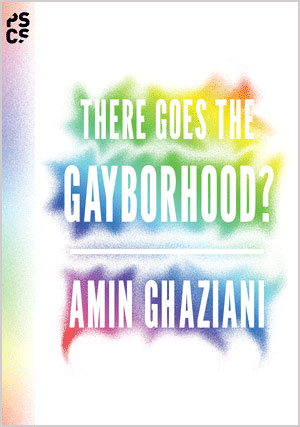 There Goes the Gayborhood?
There Goes the Gayborhood?
by Amin Ghaziani
Published by Princeton University Press
Published August 10, 2014.
Sociology (lgbt demography)
360 pgs. • Find on Amazon.com
Review by C. Todd White
Cultural sociologist Amin Ghaziani’s new book asks a question currently haunting our collective mind: What, precisely, is happening to our lesbian and gay neighborhoods?
Those of us who came out in the 1980s and ’90s reaped the benefits of 1970s lesbian and gay activism. We had a myriad of safe spaces to go to mingle with our friends, neighbors, and peers. For better or worse, many of us “came out” in the safe confines of our local gay bar or pub.

Famous “gayborhoods” like West Hollywood, Castro, Boystown, Montrose, and Center City Philadelphia boast vibrant community centers, decades of pride-parade history, MCC churches, lambda bookstores, and pubs and bars galore. But now, whether we live in these meccas or smaller towns like Trenton, New Hope, or Asbury Park, these board- ed-up or transformed places ping bittersweet memories into our minds as we drive past on our way to some chore. These places haunt us, evoking a queer nostalgia. Anyone out there remember Cuffs in Silver Lake? Omaha’s Metro? KC’s Dixie Belle? What has become of all those former retreats where we “came out” for sex, friendship, or Jell-o shots? What is to become of gay community if we cannot sustain gay places? And without gay communities, can we truly have gay culture?
Ghaziani posits that the LGBT community may be experiencing the growing pains resulting from its own success. Like a generation of gay academicians and activists who come before, he oversimplifies (and straw man-ifies) homosexuals who had Subarued to the suburbs by calling them “assimilationists.” He approaches the threshold of lamentation for our having leapt into the collective melting pot and thus lost our essence as “a people.”
We have now moved into a new era, one Ghaziani calls “post-gay.” And post-gays, like most sensible grownups, are perfectly at home living in small towns or suburbia. He hooks them to the assimilationist metaphor as early as page nine. Post-gays, he says, feel that they have moved beyond the age of persecution where safe spaces and bounded communities were needed. For them, “lesbian” or “gay” is but one aspect of a multifaceted self, an aspect that becomes less salient as we leave the gay ghettos to rejoin our faiths and families and became wedded as spouses and/or parents. Most of their friends are probably heterosexual. Some might even vote Republican.
Ghaziani uses the metaphor of a narrative journey to walk his reader through the political and historical processes that have brought us to the brink of this brave new world. He tries to keep his glass level, at once half full and half empty along the bumpy way, dodging back and forth between places lost and freedoms gained. The road ahead seems fairly straight forward, starting as it does on the edge of Stonewall and proceeding through present day. The thing is, there was a pre-gay era, too: The “homophile” movement, launched in 1953 by Harry Hay and a band of hopeful fools called Mattachine. Had Ghaziani’s narrative started there, he would have found a more cyclic progression than his story suggests. Pioneer homophile activists never sought to blend in or “assimilate,” as post-Stonewall academics and activists like Ghaziani commonly exclaim. Invisibility was not their ambition, though privacy was a luxury dearly sought. Like today’s post-gays, the homophiles desired to integrate into their communities, being visible and viable contributors. Ghaziani’s book sets the stage for some fascinating comparisons between the early homophile activism and today’s post-millennial sensibilities.
I confess disappointment in the book at first, but that is because I read it backward, starting at the beginning. Following the cognitive roadway from milepost one, it was easy to underestimate the powerful engines racing beneath Gayborhood’s stream-lined hood.
A better approach would have been to start at the end: read the appendix then proceed to the notes. Here is where the brilliance of the work unfolds. Under the guise of humble tour guide familiarizing the reader with his former neighborhood and some helpful sociological precepts, Ghaziani is actually one of the best sociologists we have working in our field. Years of diligent research undergird this commentary. For every voice he evokes from his arsenal of notes, dozens more lurk silent save for the statistics: quantitative data in sharp tables and graphs suggest a tectonic shift in the geography and demography of our gayborhoods.
This is a work to be trusted. By starting at the ending, you can better appreciate the journey of Ghaziani’s argument: Gay neighborhoods, like gays themselves, are mercurial, part blended-into and part distinct-from society at large.
Ghaziani reaches a few core conclusions. The first is that our “gayborhoods” are changing for sure and shrinking perhaps. But they are not going anywhere. He shows that many bear their history proudly. By marking historic spaces like Barbara Gittings Way in Philadelphia, Legacy Walk in Chicago, and the Mattachine Steps of Silver Lake, gays and lesbians have established places they can go to for collective nostalgia. However, for those of us who do not ride off into a suburban sunset, home may begin to look a lot like New Hope, Lambertville, Asbury Park, or Ocean Grove. This suggests that we move away from the “islands” metaphor of distinct lesbian or gay urban communities and move toward a “cultural archipelagos” model or motif.
On a side note: I found this book during the 2014 Association of LGBT Journalists conference in Chicago, heaped in the window of one of America’s few remaining LGBT bookstores, Unabridged Bookstore on North Broadway. Had I not stopped in to Unabridged Books that day, I still might not be aware of this book’s existence. And the only reason I found it there was because Ghaziani was from this neighborhood, and the shop had recently hosted its home-boy author for a reading.
While there is some encouragement to Ghaziani’s argument, that these are indeed both best and worst of times, I cannot help but be reminded—by the very book itself—that with the loss of so many gay public houses and nearly all our gay bookstores, gay culture has suffered a major blow. Where will people go now to celebrate history and learn about heritage? The big-box bookstores have strangled our literature, crushing it vice-like between Religion and Psychology. Then Amazon killed the few remaining stores, like Different Light, Oscar Wilde, and (almost) Giovanni’s Room. The Internet is rife with misinformation and Wikipedia paraphrasing. Call me old-fashioned, but sometimes I think the cyber highway is where culture goes to die.
Yet one of the most significant ways today’s post-gays resemble the homophiles just might be their reliance on social media in order to grow their communities and formulate a peculiar culture of their own. Our saving grace, and one Ghaziani fails to properly explore, will be our websites, newspapers, and magazines—much like the very one you now hold in hand. While we may be losing many of our gay places—think Studio Six and the Colosseum—we cannot afford to lose our particular spaces, in particular those in print or online.
Just as in the early days, journalists and historians are, once again, our primary carriers and curators of LGBT culture. Yet where there are lesbian and gay neighborhoods, be them large or small, so there will be need for LGBT business associations, advertising venues, community and outreach centers.
Ghaziani’s book is understandably Chicago-centric. After all, Boystown was both his home for 10 years and the site of his research. This book, though, is nationally aware, and these observations, grounded in Boystown and Andersonville, may be extrapolated onto or contrasted against other communities across the country.
This is a timely book, one well-designed for lackeys and laymen alike. If you’re looking to gift a good read to a smart friend, Ghaziani is a great way to go.
©2014, 2016 by C. Todd White. All rights reserved.
A version of this review was previously published in Out In Jersey magazine.

